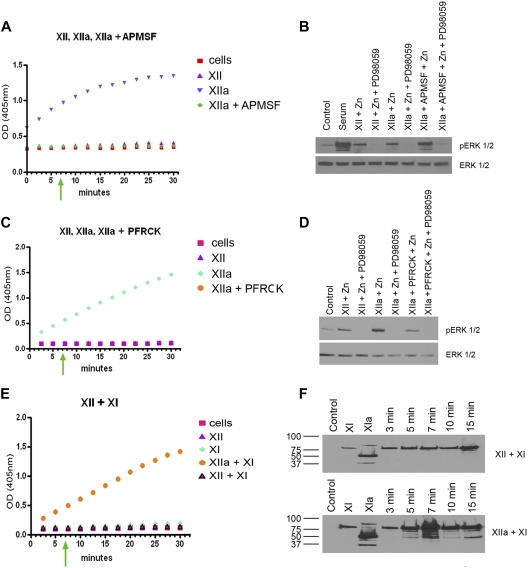Figure 2.
The role of FXII vs FXIIa in ERK1/2 phosphorylation. (A) The hydrolytic activity of 60nM FXII, FXIIa, or APMSF-treated FXIIa (FXIIa + APMSF) on 0.8mM H-D-Pro-Phe-Arg-pNA HCl is shown. (B) Serum-starved HUVECs alone (Control), serum-treated HUVECs (Serum), 60nM FXII or FXIIa in the presence of 50μM Zn2+ in the absence or presence of 50μM PD98059, or 60nM APMSF-treated FXIIa in the presence of 50μM Zn2+ in the absence or presence of 50μM PD98059 is shown on ERK1/2 phosphorylation. (C) The hydrolytic activity of 60nM FXII, FXIIa, or PFRCK-treated FXIIa (FXIIa + PFRCK) on 0.8mM H-D-Pro-Phe-Arg-pNA HCl is shown. (D) Serum-starved HUVECs alone (Control), serum-treated HUVECs (Serum), 60nM FXII or FXIIa in the presence of Zn2+ in the absence or presence of PD98059, or 60nM PFRCK-treated FXIIa in the presence of Zn2+ in the absence or presence of PD98059 is shown on ERK1/2 phosphorylation. (E) The hydrolytic activity of 60nM FXII, 30nM FXI, 60nM FXIIa + 30nM FXI, or 60nM FXII + 30nM FXI on 0.8mM pyroGly-Pro-Arg-pNA.HCl is shown. (F top) Lane 1 indicates Control; lane 2, 30nM FXI incubated over HUVECs for 7 minutes; lane 3, 30nM FXIa incubated over HUVECs for 7 minutes; lanes 4-8, 60nM FXII + 30nM FXI incubated over HUVEC monolayers for 3-15 minutes. (F bottom) Lane 1 indicates Control; lane 2, 30nM FXI incubated over HUVECs for 7 minutes; lane 3, 30nM FXIa incubated over HUVECs for 7 minutes; lanes 4-8, 60nM FXIIa + 30nM FXI incubated over HUVEC monolayers for 3-15 minutes. Both figures are immunoblots of reduced sodium dodecyl sulfate–polyacrylamide gel electrophoresis using antibody to FXI. In all panels on the left, the green arrow indicates the time of incubation of FXII or FXI in their various forms with HUVECs for the immunoblot in the adjacent panels on the right.

